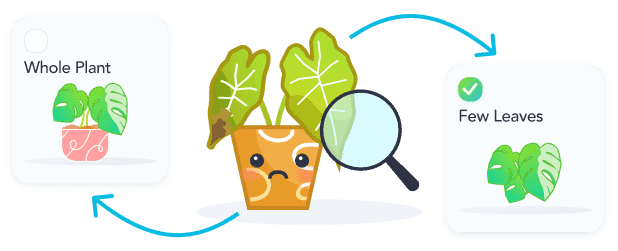Every 7d
Recommended Frequency
1 /2 cup of water
Recommended Amount
The Philodendron 'Birkin' requires consistently moist soil. Water your plant weekly during the growth period, and reduce watering in the winter.
Every 30d
Recommended Frequency
Fertilize your Philodendron once a month during spring and summer with a 20-20-20 liquid fertilizer. Fertilize every other month during autumn and winter.
Indirect Sun
Recommended
Indirect Sun or Filtered Sun is when sun exposure is being filtered through a sheer curtain or is not able to have the sun's rays directly hit the leaves/flowers of your plant.
Every 1095d
Recommended Frequency
Repot your Philodendron Birkin every three years, or once it outgrows its pot.
Peat Soil
Recommended Soil
Peat Soil is an acidic soil that retains a lot of moisture and slows decomposition. Due to such a high moisture retention this mix may require irrigation to help with draining. This soil type is best used when paired wit...

Shop Philodendron Birkin
Questions about Philodendron Birkin
The Philodendron Birkin is a striking houseplant known for its dark green leaves beautifully variegated with creamy white or yellow pinstripes. It's a relatively new variety in the Philodendron family, gaining popularity...

Toxicity of Philodendron Birkin

Common Pests and Diseases
Root Rot
Overwatering
To address root rot in Philodendron Birkin, first, stop watering immediately and allow the soil to dry out. Carefully remove the plant from its pot and inspect the roots. Trim away any black, mushy roots with sterilized scissors. Treat the remaining healthy roots with a fungicide if desired. Repot the plant in fresh, well-draining soil and a clean pot. Going forward, ensure the pot has adequate drainage holes and water only when the top inch of soil feels dry to the touch.
Leaf Curling and Drooping
Underwatering
To address leaf curling and drooping caused by underwatering, it's crucial to establish a consistent watering schedule. Philodendron Birkin prefers soil that is moist but not waterlogged. Check the soil moisture by inserting your finger about an inch deep. If the soil feels dry, it's time to water. Ensure the pot has good drainage to prevent root rot. During warmer months, you may need to water more frequently. Adjust your watering schedule according to the season and your indoor environment.
Spider Mite Infestation
Spider mites are tiny pests that thrive in warm, dry conditions. They feed on the sap of the Philodendron Birkin, causing yellowing, speckled leaves, and webbing on the plant.
To combat spider mites, first isolate the affected plant to prevent spread. Increase humidity around your Philodendron Birkin, as spider mites prefer dry conditions. Wash the plant gently with water to remove mites and their webs. For severe infestations, use a miticide or neem oil, applying it according to the product's instructions. Regularly check the plant and repeat treatment if necessary. Maintaining a clean environment and monitoring your plants regularly can prevent future outbreaks.
Leaf Spot Disease
Fungal or bacterial pathogens
To manage leaf spot disease, start by removing and destroying any affected leaves to prevent the spread. Improve air circulation around your Philodendron Birkin by spacing plants properly and avoiding overhead watering to keep foliage dry. If the problem persists, apply a fungicide or bactericide, following the product's instructions carefully. Ensure your plant is not stressed by providing optimal light and nutrition, as a healthy plant is more resistant to diseases.

Related Plants
Other Articles:
Top 10 Most Popular Roses
Mar 22, 2022
How to Care for China Roses
Mar 11, 2022
How to Care for Chinese Money Plants
May 15, 2020
How to Grow and Care for A Bird of Paradise
Apr 26, 2020
Top 10 Plants To Grow In A Terrarium
May 31, 2022
How to Grow and Care for Lucky Bamboo
Mar 29, 2022
How to Grow and Care for Corn Plants
Mar 29, 2022
How to Care for Madagascar Dragon Trees
Mar 21, 2022



